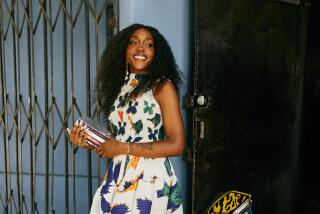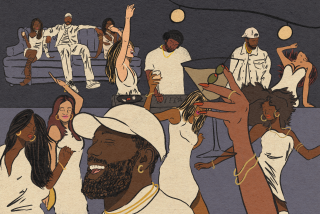Alice Still Lives Here, in the Form of a New Feminist Zine
- Share via
The name Alice is familiar, but by no means sexy. It belongs to the inquisitive young heroine in “Alice in Wonderland,” and the unmarried maid of TV’s “The Brady Bunch,” neither of whom have the kind of face that would launch a thousand ships . . . or a new cosmetics line, for that matter.
But the name captures the mission of Diane Anderson Minshall’s new bimonthly feminist zine Alice perfectly: an alternative to what she sees as a myopic attitude by the publishers who marginalize women outside the mainstream. “For women on the other side of the looking glass” is Alice’s slogan.
“Women of color or women from alternative backgrounds--be it sexuality or lifestyle or cultural background that isn’t necessarily tied to race--were forced to pick up dozens of magazines to get a balanced view,” said Anderson Minshall, who is based in Sunnyvale, Calif. “But we feel like young women today are very interested in seeing a diversity of images and articles that speak to their varied cultural backgrounds.”
Alice, which has a print run of 10,000, is by no means alone in the world of feminist or “grrl” zines. It focuses on one angle of feminist publishing which the grandmother of them all, Ms. magazine, perfected in the 1970s. And it comes on the scene during a particularly prolific time for small alternative women’s print publications (many of which also have Web sites).
At chain bookstores and larger newsstands today, you’ll find Bust (“The voice of the new girl order”), Bitch (“The feminist response to pop culture”), Girlfriends, Moxie, Fabula, Hip Mama, Rockrgrl, Radiance and dozens of smaller zines. Circulation-wise, though the numbers usually range into the mid-five figures, the zines are tiny compared to mainstream women’s magazines, such as Cosmopolitan, Redbook and Glamour, with paid circulations from 2.2 million to 2.9 million.
Zine topics range from a study of the portrayal of witches in TV and film to an article about botched vaginal rejuvenation surgery. The May/June issue of Alice includes interviews with singer Toni Braxton about the sexual double standard endured by black women; with Pakistani-American model Lubna Khalid, who founded her own cosmetic company and Hawaiian-born actress Kayla Blake, who plays a producer on TV’s “Sports Night.”
Samir Husni, a University of Mississippi journalism professor who tracks magazine launches in the U.S., attributes the proliferation of feminist zines to the fierce passion of their readers. “In a nutshell--it’s a cult,” he said, “I mean that in a positive way.”
“Every time you’re publishing something for a cult, you’ve got a dedicated group of followers. So once you are a ‘Moxie girl’ or a ‘Bitch girl,’ you want that. You feel you get all of your vitamins and energy from that one magazine.”
Filmmaker Kara Herold, 31, says she was introduced to feminist zines by the book “A Girl’s Guide to Taking Over the World: Writings from the Girl Zine Revolution,” edited by Tristan Taormino and Karen Green (St. Martin’s, 1997). She was so impressed with the zines that she made a 20-minute documentary film about the phenomenon called “Girly Show.” (She showed it recently at the Santa Barbara Zine Fest and she’s submitting it to film festivals.) “All these women were out there writing about what they felt was important to them, and their world, which you don’t see anywhere in mainstream publishing,” she said. “It was validating.”
In 1999, there were 12 new women’s magazine launches out of a total of 864 new magazine launches in the U.S. that year. Half of the 864 will die before the end of the first year, says Husni, and only 15% will survive beyond four years. The statistics don’t bode well for independent publishers, but that doesn’t mean the grrls should be written off just yet.
“If success means you are still publishing, then yes, they are successful,” Husni says of some of the titles, such as Bust, which have already passed the four-year mark. “But if it means making money, that’s a different thing.”
For many independent publishers, editorial integrity is the raison d’ etre and biggest roadblock to financial success. “Advertisers will not advertise in publications that do not cover their product category in a favorable way,” says Lysa Miya-Jervis, 28-year-old editor and publisher of the San Francisco-based Bitch. “So women’s magazines end up running articles about lipstick. That’s what makes these magazines so stupid . . . women don’t need to read about how to apply lipstick.” (The current issue of Alice has a story on red lipstick, illustrated with mehndi-type designs painted on the bodies of male models.)
Emily Hancock, editor and publisher of Moxie, a Berkeley-based quarterly about “real women doing real things in the real world,” echoes the sentiment. “I think people are fed up with fashion, sex and beauty,” she said. “They want more out of a mag than how to play into the hands of man. Moxie readers are smart, gutsy women who don’t need a quiz to figure out what to do in bed.”
As the more established magazine of the bunch, New York-based Bust has thrived by developing healthy relationships with advertisers such as record labels rather than the more editorially-demanding cosmetics companies. “The music community, in particular, really appreciates the culture of grass-roots publishing,” says Bust co-founder Marcelle Karp, 36. “They’ve always been incredibly supportive of us.”
A supportive environment exists among the publishers as well. “They’ve been very good about supporting each other through ad swaps and subscriber list trades,” says Rona Fernandez of the nonprofit Independent Press Assn.
“All of us are in this together,” says Karp. “The more zines like Bust and Bitch that are out there, the better off all women are.”
More to Read
Sign up for our Book Club newsletter
Get the latest news, events and more from the Los Angeles Times Book Club, and help us get L.A. reading and talking.
You may occasionally receive promotional content from the Los Angeles Times.









